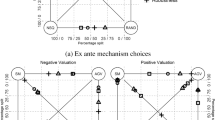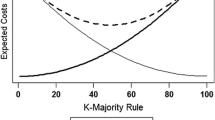Conclusions
The principal findings of this experiment are: It is somewhat time-consuming but not otherwise difficult to employ the demand-revealing process in groups of 10 to 60. The ability of the demand-revealing process to take account of intensities of preferences is appreciated by many of the persons who have used the process, but the departure from one-man-one-vote is strongly resisted by others. The outcomes reached by demand-revealing differed from majority rule in about one-tenth of the cases. The improvement in efficiency associated with these reversals of majority rule was 2.25 percent of the net benefit of making the efficient decisions. The Clarke taxes, which would decline in percentage terms as group size increased, were 3.04 percent of the net value of efficient decisions for the decisions studied.
Similar content being viewed by others
References
Bohm, P. (1972). Estimating demand for public goods: An experiment. European Economic Review 3: 111–130.
Clarke, E.H. (1971). Multipart pricing of public goods. Public Choice 11: 19–33.
Groves, T. (1973). Incentives in teams. Econometrica 41: 617–631.
Groves, T., and Loeb, M. (1975). Incentives and public inputs. Journal of Public Economics 4: 211–226.
Ferejohn, J., Forsythe, R., and Noll, R. (1979). Practical aspects of the construction of decentralized decision-making systems for public goods. In C.S. Russel (Ed.), Collective decision making. Baltimore: The Johns Hopkins University Press.
Plott, C. (1979). The application of laboratory experimental methods to public choice. In C.S. Russel (Ed.), Baltimore: The Johns Hopkins University Press.
Scherr, B., and Babb, E. (1975). Pricing public goods: An experiment with two proposed pricing systems. Public Choice 23: 35–48.
Smith, V.L. (1979a). An experimental comparison of three public good decision mechanisms. Scandinavian Journal of Economics, 198–215.
Smith, V.L. (1979b). Incentive compatible experimental processes for the provision of public goods. In V. Smith (Ed.), Research in experimental economics. Greenwich: JAI Press.
Tideman, N., and Tullock, G. (1976). A new and superior process for making social choices. Journal of Political Economy 84: 1145–1159.
Vickrey, W. (1961). Counterspeculation, auctions, and competitive sealed tenders, Journal of Finance 16: 1–17.
Author information
Authors and Affiliations
Additional information
This research grew out of Gordon Tullock's suggestion that experiments with the demand-revealing process were needed. It started as a joint project of the two of us. As it developed, my share of the effort increased to the point where he suggested that I should accept all author's responsibility. Helpful suggestions of Charles Plott and Subroto Roy are gratefully acknowledged. Marvin Ballard and Jane Smith provided invaluable research assistance. Stephen Sheppard provided both computer assistance and substantial general counsel. The research was supported by a grant from the National Science Foundation.
Rights and permissions
About this article
Cite this article
Tideman, T.N. An experiment in the demand-revealing process. Public Choice 41, 387–401 (1983). https://doi.org/10.1007/BF00141071
Issue Date:
DOI: https://doi.org/10.1007/BF00141071




